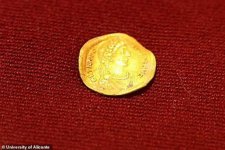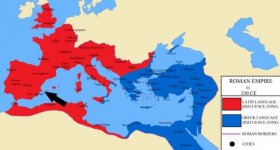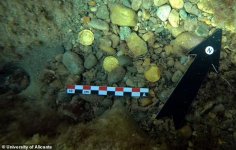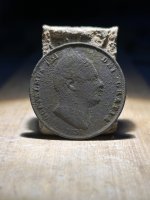- Feb 2, 2013
- 1,421
- 1,985
- Detector(s) used
- Many
- Primary Interest:
- All Treasure Hunting
Two amateur divers cleaning trash from the seabed of Alicante while holidaying off the coast of Spain have uncovered a cache of 1,500-year-old gold Roman coins. Numbering 53 in total, the gold coins are in a ?perfect state of conservation? and are dated to the late 4th and early 5th century.
The stash was found by brothers-in-law Luis Lens and C?sar Gimeno, who came across the extraordinary discovery in seven meters (23 feet) of water deep off the coastal town of X?bia. ?I thought I had found what looked like a 10 cent coin. It was in a small hole, like a bottleneck,? Lens was quoted by the Daily Mail as saying.
A Fine State of Preservation-
Local experts and the authorities immediately responded to the find. Archaeologists from the University of Alicante and the Spanish Civil Guard Special Underwater Brigade (GEAS), in collaboration with the Town Council of X?bia, carried out several dives in the area. These resulted in the aforementioned discovery of the coins, along with three copper nails, and deteriorated lead remains which were probably once a sea chest.
The finds were analyzed by scientists from the University of Alicante Research Institute in Archaeology and Historical Heritage (INAPH). They have dated the finds to the late Roman period, in particular between the end of the 4th century and the beginning of the 5th century.
Together, they carried out survey, documentation and photogrammetry work of the site. Experienced underwater archaeologists with extensive national and international experience are continuing to survey the area
The state of preservation is so good that one can read the inscriptions on these coins, which are directly identifiable with the reign of various Roman emperors. The coins come from the reigns of Valentinian I (3 coins), Valentinian II (7 coins), Theodosius I (15 coins), Arcadius (17 coins), Honorius (10 coins), with one coin remaining unidentified, reports UA News .
The Fall of the Western Roman Empire-
Jaime Molina, a researcher at the University of Alicante, said, ?This is one of the largest sets of Roman gold coins found in Spain and Europe. It's an exceptional archaeological and historical find since its investigation can offer a wealth of new information to understand the final phase of the fall of the Western Roman Empire.?
This, of course, refers to the final days of the Roman empire, when it came under siege by various Germanic kings, ?invading tribes? whom the Romans referred to as ?barbarians.? The empire would finally fall in 476 to the Germanic barbarian king Odoacer, who defeated the last Western Roman emperor, Romulus Augustulus.
The Eastern Roman Empire, also known as the Byzantine empire , would survive for another millennium, until Constantinople was taken over by the Ottoman Turks in 1453.
?There are no remains of sunken ships in the area where they were found so it is probably a voluntary concealment from the arrival of the barbarians to the coast of Hispania, in this case, the Alans. This finding speaks to us of a context of fear, of a world that is ending, that of the Roman Empire. The find illustrates a historical moment of extreme insecurity with the violent arrival in Spain of the barbarian peoples and the definitive end of the Roman Empire in the Iberian peninsula from 409 AD.?
It is therefore most likely that the Romans, whose power was dwindling and who feared looting from the Alans, hid the coins vountarily. The Alans had certainly come a long way: they were, by ethnicity, originally ancient and medieval nomadic-pastoralists from Iran and the North Caucus.
After a circuitous route around Europe, they finally crossed the Rhine in 406 AD along with the Vandals and Suebi. All three peoples then crossed the Pyrenees into Spain three years later, in 409 AD. During this time the Romans experienced increasingly frequent raids, looting, and plunder by the Alans.
The bay of Portitxol in X?bia has a history of underwater archaeological remains, many of which are currently under study by various scientific and archaeological bodies. Previous finds have included anchors, amphorae cargoes, ceramic and metallic remains, and materials associated with ancient navigation.
Following the latest find, the Valencian Government has allocated a budget of ?18,000 to carry out underwater research and analysis.


https://www.ancient-origins.net/news-history-archaeology/roman-coins-0015869
The stash was found by brothers-in-law Luis Lens and C?sar Gimeno, who came across the extraordinary discovery in seven meters (23 feet) of water deep off the coastal town of X?bia. ?I thought I had found what looked like a 10 cent coin. It was in a small hole, like a bottleneck,? Lens was quoted by the Daily Mail as saying.
A Fine State of Preservation-
Local experts and the authorities immediately responded to the find. Archaeologists from the University of Alicante and the Spanish Civil Guard Special Underwater Brigade (GEAS), in collaboration with the Town Council of X?bia, carried out several dives in the area. These resulted in the aforementioned discovery of the coins, along with three copper nails, and deteriorated lead remains which were probably once a sea chest.
The finds were analyzed by scientists from the University of Alicante Research Institute in Archaeology and Historical Heritage (INAPH). They have dated the finds to the late Roman period, in particular between the end of the 4th century and the beginning of the 5th century.
Together, they carried out survey, documentation and photogrammetry work of the site. Experienced underwater archaeologists with extensive national and international experience are continuing to survey the area
The state of preservation is so good that one can read the inscriptions on these coins, which are directly identifiable with the reign of various Roman emperors. The coins come from the reigns of Valentinian I (3 coins), Valentinian II (7 coins), Theodosius I (15 coins), Arcadius (17 coins), Honorius (10 coins), with one coin remaining unidentified, reports UA News .
The Fall of the Western Roman Empire-
Jaime Molina, a researcher at the University of Alicante, said, ?This is one of the largest sets of Roman gold coins found in Spain and Europe. It's an exceptional archaeological and historical find since its investigation can offer a wealth of new information to understand the final phase of the fall of the Western Roman Empire.?
This, of course, refers to the final days of the Roman empire, when it came under siege by various Germanic kings, ?invading tribes? whom the Romans referred to as ?barbarians.? The empire would finally fall in 476 to the Germanic barbarian king Odoacer, who defeated the last Western Roman emperor, Romulus Augustulus.
The Eastern Roman Empire, also known as the Byzantine empire , would survive for another millennium, until Constantinople was taken over by the Ottoman Turks in 1453.
?There are no remains of sunken ships in the area where they were found so it is probably a voluntary concealment from the arrival of the barbarians to the coast of Hispania, in this case, the Alans. This finding speaks to us of a context of fear, of a world that is ending, that of the Roman Empire. The find illustrates a historical moment of extreme insecurity with the violent arrival in Spain of the barbarian peoples and the definitive end of the Roman Empire in the Iberian peninsula from 409 AD.?
It is therefore most likely that the Romans, whose power was dwindling and who feared looting from the Alans, hid the coins vountarily. The Alans had certainly come a long way: they were, by ethnicity, originally ancient and medieval nomadic-pastoralists from Iran and the North Caucus.
After a circuitous route around Europe, they finally crossed the Rhine in 406 AD along with the Vandals and Suebi. All three peoples then crossed the Pyrenees into Spain three years later, in 409 AD. During this time the Romans experienced increasingly frequent raids, looting, and plunder by the Alans.
The bay of Portitxol in X?bia has a history of underwater archaeological remains, many of which are currently under study by various scientific and archaeological bodies. Previous finds have included anchors, amphorae cargoes, ceramic and metallic remains, and materials associated with ancient navigation.
Following the latest find, the Valencian Government has allocated a budget of ?18,000 to carry out underwater research and analysis.
https://www.ancient-origins.net/news-history-archaeology/roman-coins-0015869








